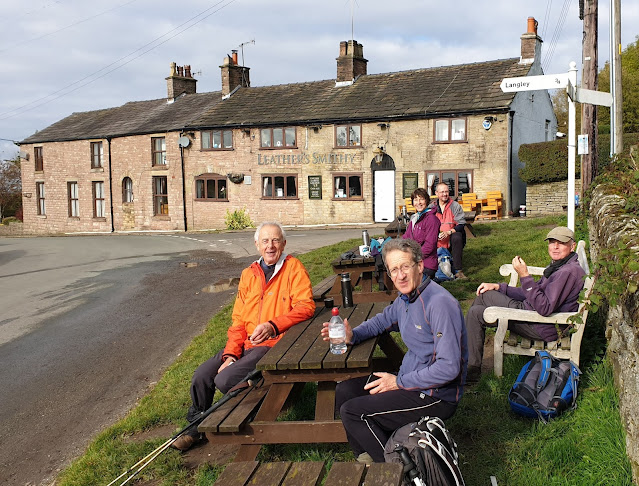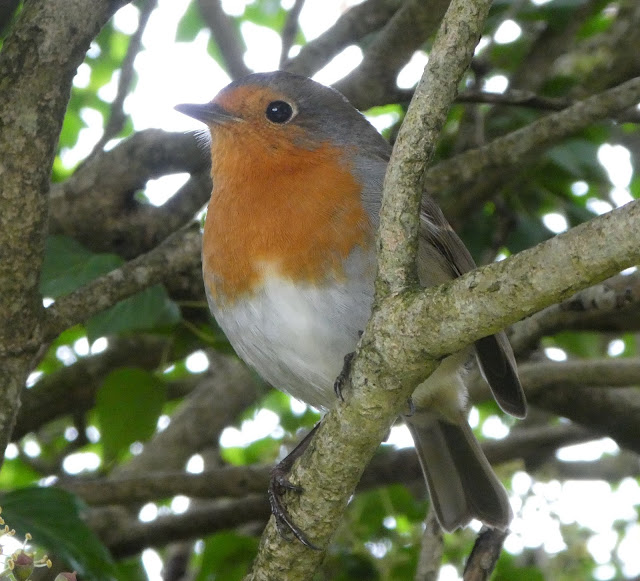 |
Click on the image for a slideshow
|
Whilst it wasn't sunny, the weather did behave itself for this lovely autumn stroll, with Sue and I being joined by Paul, Graeme, Cary and JJ. We wrestled our way to Tegg's Nose Visitor Centre, despite a road closure, and put our coins into the machine (well, we put in Graeme's coins as Sue and I had forgotten ours. Thanks Graeme.)
The view of Shutlingsloe from the car park is shown above. There's a bit of history to the place where we were standing; the name, Tegg's Nose, may originate from a time when a local Norseman named Tegga owned the land (naze). Or you might prefer the theory that 'tegg' is an old name for a lamb, and it's said that before the extensive quarrying, the hill's profile resembled that of a sheep.
The millstone grit rock of which Tegg's Nose is composed is an especially hard sandstone that is excellent for building both roads and houses. The whole area is home to many quarries. Tegg's Nose Quarry closed in 1955 and reopened as a country park in 1972. The site is 'littered' with displays of an assortment of old quarrying tools and machinery and plentiful information boards.
The area has been a hive of industry in the past, with quarries for stone which was crushed on site by heavy machinery, the relics of which have been preserved. As have the quarry walls, which are now fitted with abseil points and are used for training aspiring climbers.
We made our way slowly to a viewpoint.
It's a fine view over Cheshire, from Mow Cop to our far left, past Jodrell Bank telescope (seen in the picture below), to White Nancy above Bollington on our far right.
Then from another viewpoint overlooking our route, the reservoirs above Langley stand out, with Shutlingsloe to their left.
We made our way down to the reservoirs, and admired the autumn colours as best we could without the added vibrancy that a bit of sunshine would have provided.
Here's a tractor for Alan R.
We'd been on the Gritstone Trail since the start of the walk, and we could look back past a flock of Canada Geese and other birds to the modest protuberance of Tegg's Nose.
We then deserted the Gritstone Trail and made our way to the picnic benches outside the Leather's Smithy for elevenses.
The pub takes its name from the first licensee, William Leather. There's a plaque dated 1821, but the building may be older than that. For a while it was called the 'New Inn'. This stems from the mid 1800s, before which time ale houses only sold ale, usually home-brewed, and porter (a dark brown bitter beer brewed from charred or brown malt - originally made for porters). When a new law was passed allowing licences to be granted for pubs to sell wines and spirits as well as ale and porter, many pubs changed their names to the 'New Inn' to show that they had the new licence.
My stock of brownies had long been eaten, but Sue brought some of her chocolate caramel shortbread and JJ handed round some lovely chocolatey tiffin. The only problem was my flask of tea, which Sue pronounced "disgusting"!
After a lengthy break that contributed to today's (not)parkrun time for 5 km of 1:51:14, we took easy paths through Macclesfield Forest up to the main road at Walker Barn.
The mature plantations that form the forest were first planted by Macclesfield Water Board around 1928, and consist mainly of larch and spruce, which do well on the poor soil. It's maybe a similar story from many forests, but the last wolf in England is reputed to have been slain while prowling through Macclesfield Forest.
En route we passed a tumbledown building that JJ went to investigate. It seems that a war veteran may have lived there, or even built it.
Pleasant field paths led on after we left the forest, with JJ and Graeme hurrying past the bull.
Sue fed it some grass. She was quite oblivious of its sex.
Andrew J may not have appreciated the descent from this stile leading onto the road to Walker Barn. Luckily he wasn't with us, but our thoughts were with him and with others currently leading difficult lives.
From Walker Barn we could have strolled up the road to the car park, but we chose to continue along the path to Gulshaw Hollow.
And a very nice path it was too, leading past Hordern Farm and re-joining the Gritstone Trail to double back to Tegg's Nose.
Here's the excellent route, which was based on Jen Darling's 'Around Tegg's Nose' route from the Leather's Smithy in her book 'More Pub Walks in Cheshire and Wirral. It was about 11 km, with 400 metres ascent, taking us three and a half hours at a very leisurely pace.
Thanks go to Jen for the route and for some of the historical information that I've cadged from her book.

































































